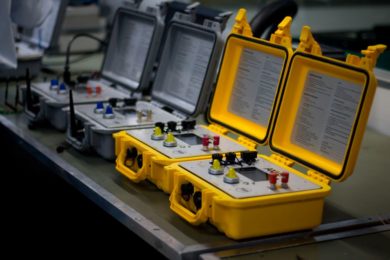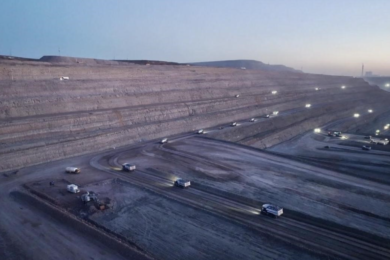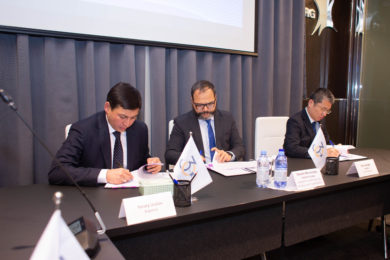
With the third global IPCC 2013 conference getting ever closer – being held in the Hilton Cologne from 13th to 15th October, it is a good time to get caught up with the progress on some of the major IPCC projects that are currently either well underway or close to commissioning. Notable among these are Hongsa, Pingshuo, Tutupan and of course, Vale’s S11D.
The Hongsa Mine Mouth Project in Laos continues to progress. The mine has a current total lignite reserve of 436.9 Mt, with proven reserves of approximately 370.8 Mt. To excavate the lignite reserve, 1,250 Mbcm of overburden and interburden have to be removed, resulting in an average stripping ratio of about 3.4:1. Assuming an average annual lignite production of 14.3 Mt the reserves of the Hongsa opencast mine would last for 26 years of operation. As lignite is relatively flammable, and the power plant is located adjacent to the mine, there will be a stockpile of lignite sufficient for two weeks of operation adjacent to and northeast of the power plant, as security against any interruption to mining operations. The stockyard will serve both as a lignite supply buffer as well as a lignite quality blending area. The lignite of the desired quality will then be transported to a transfer tower behind the stockyard, the handover point between the mine and the power plant, which will have a lignite reclaiming conveyor system with twin 100% duty conveyors.
MMD received the order for nine semi-mobile sizer stations for Hongsa, five of which will be processing overburden/clay and four lignite. The units are designed for frequent relocation using a crawler transporter. The first of these units are currently under manufacture and will be in operation by mid-2014 with all nine units completed in 2015.
Sandvik, for its portion of the contract delivery to Hongsa, is delivering 15 PC200 conveyors, two slewing stackers (PS200- 1800/38), three bridge type reclaimers (PR300-1400/52), two secondary crushers, five PC300 relocatable mine conveyors, two PC300 relocatable mine conveyors, one spreader PA200-2600/52+50 with tripper car, and two PT300 transport crawlers.
 The other major project nearing delivery from MMD is the delivery of a fully mobile sizer to Pingshuo. This machine is currently being assembled and is on track to be commissioned by the third quarter of 2013. The contract is for China Coal, with the machine to be used for the Pingshou East Open Pit mining area in Shanxi Province. The system has been jointly supplied by MMD in the UK and its wholly owned subsidiary MMD China, based near Beijing. The core MMD components were manufactured in the UK with the balance being manufactured, sourced and assembled by the Chinese team who will, with the support of the MMD IPCC team, is also conducting the site assembly. The unit represents the first of the third generation MMD high capacity (>5,000 t/h fully mobile) sizing units to go into operation. The system will be used to handle overburden, consisting primarily of sandstone with a hardness of up to 120 MPa and density of 2.7kg/cm³. The horizons contain several muddy layers and are expected to get sticky in the short wet season, as the daily precipitation can exceed 150 mm/d. The material deposits, from the 15 m high benches of up to 1,540 m in length, will be loaded in to the MMD Mobile Sizer by a 60 m³ capacity rope shovel. The material will then be transferred from the 150 m³ hopper by a low angle MMD D9 apron plate feeder, capable of providing a controlled flow rate of up to 10,000 t/h, to the MMD twin shaft mineral sizer. The sizer will reduce the ROM material to a product size suitable for belt conveying (400 mm) before feeding it on to a short transfer conveyor which carries it to an integral luffing/slewing discharge conveyor.
The other major project nearing delivery from MMD is the delivery of a fully mobile sizer to Pingshuo. This machine is currently being assembled and is on track to be commissioned by the third quarter of 2013. The contract is for China Coal, with the machine to be used for the Pingshou East Open Pit mining area in Shanxi Province. The system has been jointly supplied by MMD in the UK and its wholly owned subsidiary MMD China, based near Beijing. The core MMD components were manufactured in the UK with the balance being manufactured, sourced and assembled by the Chinese team who will, with the support of the MMD IPCC team, is also conducting the site assembly. The unit represents the first of the third generation MMD high capacity (>5,000 t/h fully mobile) sizing units to go into operation. The system will be used to handle overburden, consisting primarily of sandstone with a hardness of up to 120 MPa and density of 2.7kg/cm³. The horizons contain several muddy layers and are expected to get sticky in the short wet season, as the daily precipitation can exceed 150 mm/d. The material deposits, from the 15 m high benches of up to 1,540 m in length, will be loaded in to the MMD Mobile Sizer by a 60 m³ capacity rope shovel. The material will then be transferred from the 150 m³ hopper by a low angle MMD D9 apron plate feeder, capable of providing a controlled flow rate of up to 10,000 t/h, to the MMD twin shaft mineral sizer. The sizer will reduce the ROM material to a product size suitable for belt conveying (400 mm) before feeding it on to a short transfer conveyor which carries it to an integral luffing/slewing discharge conveyor.
An independent mobile 70m long bridge conveyor, also part of MMD scope, feeds the MMD mobile hopper car mounted over the relocatable face conveyor. When in full production, the MMD Mobile Sizer will move hourly, with the normal advance being a distance of 5m.
FLSmidth is currently supplying to PT Adaro Indonesia a turnkey IPCC system for handling coal overburden at the Tutupan mine located in South Kalimantan. The system is rated for 12,000 metric tonnes per hour and consists of two semi-mobile sizer stations, approximately 9 km of fixed overland conveyors and a mobile stacking system. The mobile stacking system includes an extendable overland conveyor, a relocatable overland conveyor with a mobile tripper, a mobile stacking conveyor with a mobile tripper and a spreading conveyor. The system is currently in wet commissioning phase with full operation expected in the third quarter of 2013.
Vale’s S11D project, which amongst other equipment includes fully mobile IPCC stations from Sandvik and mobile jaw crushers from ThyssenKrupp, represents the other big project that the wider mining industry is keeping a close eye on, and will form the subject of papers at the forthcoming IPCC 2013 conference in Cologne. SKM has a $76 million implementation contract for the truckless component and will provide engineering for the truckless system, procurement support, project execution planning and project management services.
 SKM recently released a commentary on the wider truckless mining market and referred to the project benefits from an environmental and skills shortages standpoint: “As the typical scale of new mining projects grows larger, and with projects increasingly based in remote and inhospitable locations, ‘truckless mining’ is attracting interest globally for its sustainability benefits and potential to lower operating costs. Newer mine sites tend to be larger as a result of declines in the quality of reserves and further and further away from established infrastructure. The accompanying challenges include getting skilled people into these mine locations and actually delivering a project with the necessary approvals, environmental requirements and the social licence to operate from the local communities. SKM has been working with Vale Iron Ore on its S11D operation in a remote and environmentally sensitive area in the northern Brazilian state of Pará. With no local skill-base to operate and maintain a large, new mine that is expected to produce 90 Mt of iron ore a year, using traditional methods to transport ore from the mine by truck to the stockpiles was always going to be difficult. Not only would this require a vast fleet operating on very steep terrain, but the associated costs over a 30 year mine life would be prohibitive.”
SKM recently released a commentary on the wider truckless mining market and referred to the project benefits from an environmental and skills shortages standpoint: “As the typical scale of new mining projects grows larger, and with projects increasingly based in remote and inhospitable locations, ‘truckless mining’ is attracting interest globally for its sustainability benefits and potential to lower operating costs. Newer mine sites tend to be larger as a result of declines in the quality of reserves and further and further away from established infrastructure. The accompanying challenges include getting skilled people into these mine locations and actually delivering a project with the necessary approvals, environmental requirements and the social licence to operate from the local communities. SKM has been working with Vale Iron Ore on its S11D operation in a remote and environmentally sensitive area in the northern Brazilian state of Pará. With no local skill-base to operate and maintain a large, new mine that is expected to produce 90 Mt of iron ore a year, using traditional methods to transport ore from the mine by truck to the stockpiles was always going to be difficult. Not only would this require a vast fleet operating on very steep terrain, but the associated costs over a 30 year mine life would be prohibitive.”
The group also made comparisons to the continuous lignite mines in Germany, which will be visited by the IPCC 2013 field trip: “While autonomous trucks and driverless trains operate successfully in Western Australia’s Pilbara region by remote control from Perth, they weren’t suited to the S11D mine. Instead of trucks being used to move material away from the mining face to somewhere else for processing, Vale has chosen to take a conveying system that would normally be outside the pit right up to the mine face. The conveyors will be cheaper to operate once they’re installed, despite the actual costs of setting them up. While IPCC systems are not new, they have usually only been successful in quite specific types of mines, ie brown coal mines in East Germany and the Latrobe Valley in Australia. These mines employ strip mining methods in straight benches with conveyors moving regular material that doesn’t need various mining techniques to successfully extract the ore. The innovation at S11D was to recognise the similarities between this Brazilian iron ore mine near the Amazon River and an East German brown coal mine, where a similar approach would actually offer solutions to some of their other challenges. At a more technical level, some of the mining system challenges are very innovative because of the steep terrain in Brazil.”
Inside the pit, the Sandvik 2,000 t mobile mining machines and two kilometre-long conveyors will be moving with and around each other, while also working around the drilling, blasting and mining – all without endangering safety or production. The transfer conveyors drop 400 m from the pit to the dumps over a distance of 4 km, carrying about 9,000 t of material. The strength of the belt alone is right at the limit of what the industry can currently manage. SKM went on to also summarise its checklist for mining owners considering IPCC. It believes that for all projects, the owner should have confirmed the following:
■ That the layout of the reserve and material type is suitable for strip-mining techniques favoured by IPCC systems, where benches are predominantly regular and long
■ That a downstream system is available and suited to receiving material from a conveying system where dumps won’t require excessively difficult or expensive conveyor movements in order to be built
■ That a reliable and affordable power supply is available
SKM believes that if the project cannot “pass these gates with confidence”, then the suitability of an IPCC system is under question from the start. Concluding with another reference to S11D in terms of a differing approach to the project delivery team, SKM stated: “We recognised very early on in the Vale S11D studies that the mine planning team needed to be integrated within the engineering group, an unusual step but one that has paid great dividends. With a system like S11D, where the conveyors are in the pit at the mining face, really close attention must be devoted to how the conveyors interact with the mine face because that affects production, costs, relocation times and more. By enabling close interaction between the miners and the mechanical engineers to mitigate all those risks is unusual but it has paid off well.”
There are also others who believe that strip mines are by no means the be all and end all for IPCC. Mining Engineer Doug Turnbull told IM: “Having just completed three detailed assessments of irregular shaped pits to see if IPCC could be made work – it did and paid very well. While IPCC is easiest to conceptualise in strip mines, that IPCC is largely restricted to these types of mines is a myth based on the fact that it is just difficult to make other pit shapes work with IPCC – but work they can if mine planning engineers get out of the ‘truck thinking box’ and go back to mining engineering 101. There is still no commercially available software planning package to suit IPCC but at least a few of the programmers are thinking about how they can incorporate it as an add-on box to existing truck based planning/scheduling packages.” IM









